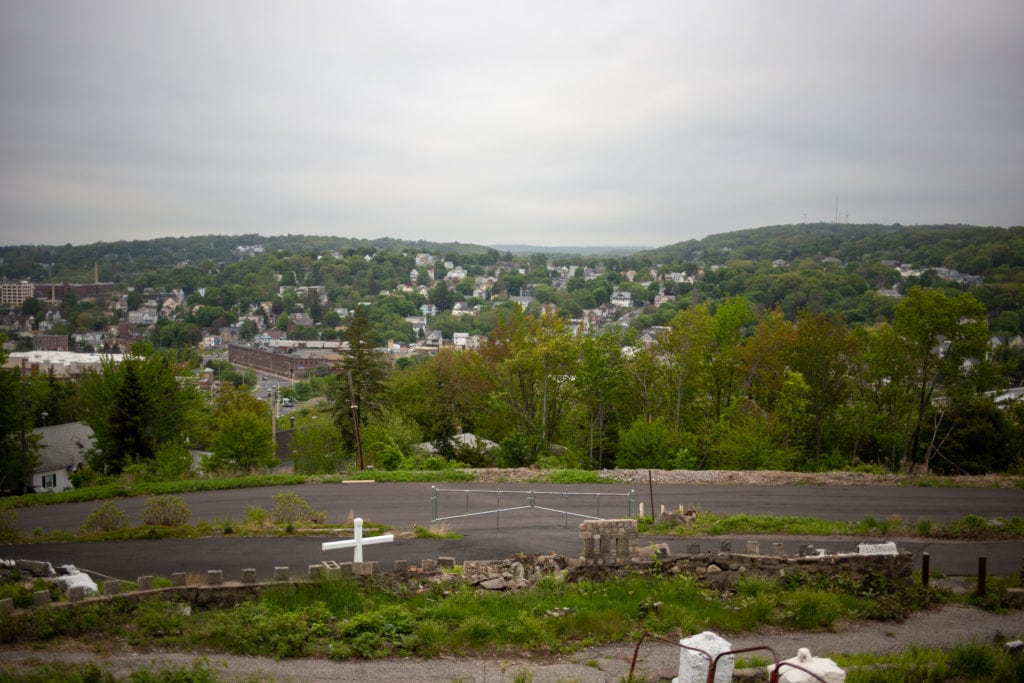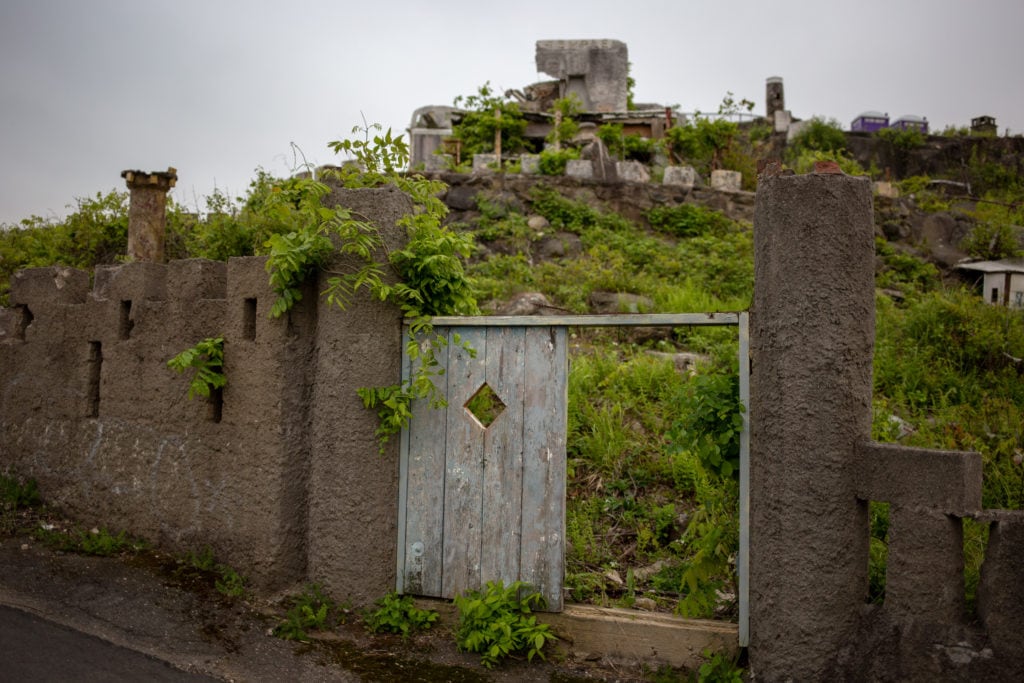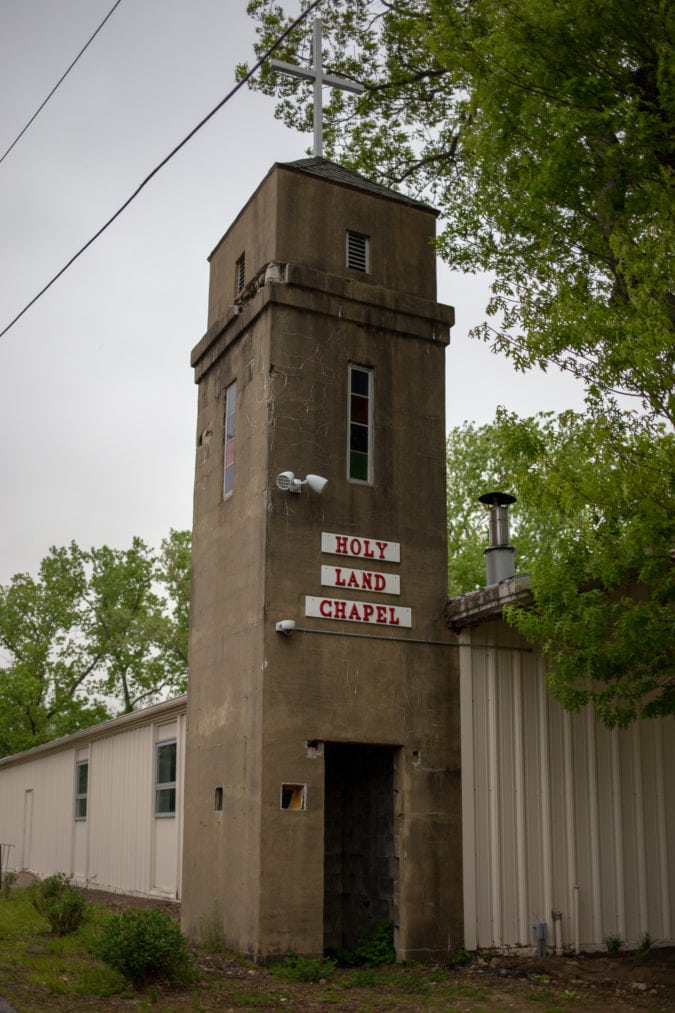Nearly 3,000 miles east of the famous Hollywood sign is another hilltop sign, visible from a nearby highway. Although not as nationally-known as its California counterpart, the sign that spells out “Holy Land U.S.A.” in huge, white letters is still a Waterbury, Connecticut landmark 35 years after the park it advertises officially closed to the public.
Holy Land opened in the late 1950s and the religious theme park (not to be confused with an amusement park) never had rides, carnival games, or funnel cakes—but it did have a snack bar, a gift shop, and a hillside covered with structures and statues based on stories and people mentioned in the Bible. Standing above it all was an illuminated, 56-foot cross.

At its peak in the ‘60s and ‘70s, Holy Land welcomed 40,000 visitors a year. After the park closed in 1984, its popularity with urban explorers and exposure to the elements accelerated the decay of the mostly-concrete structures. In 2010, a 16-year-old girl was raped and murdered at Holy Land, adding to its infamy.
Although it still sits essentially abandoned, church officials and members of the community have recently rallied around Holy Land, repainting structures, repaving roads, and restoring some of the attractions. In a turn of events that may be familiar to people of faith, the park appears to be in the midst of a resurrection.
Crumbling in Connecticut
When I visited Holy Land in May, I expected to be greeted with the usual set of tricks implemented to keep out explorers—”no trespassing” signs, fencing, barricades, and maybe even security cameras. Instead, I found a very new vinyl banner welcoming visitors to Holy Land and several families dressed in their Sunday best taking photos among the overgrown, crumbling structures.








Built by John Greco, a Waterbury lawyer and devout Catholic, Holy Land is full of statues depicting religious figures and small-scale replicas of Solomon’s Temple, the Kings’ Tombs, Pater Noster Sanctuary, Grotto of the Holy Family, Tower of Babel, and Herod’s Palace. The stations of the cross have recently received a fresh coat of red and white paint, but other structures—built with scrap materials and repurposed items—are in various states of decay; rusty rebar is poking out of the concrete, vines creep in and out of tombs, and Bible verses can only be read by piecing together the fragments that remain.
”[Greco] was a very spiritual man,” Bob Chinn, a former grounds chairman at Holy Land, told the New York Times in 2001. ”He wanted to do this for the people of the community. He felt no one, no matter the race, creed or color, should be separated.”


Today, Holy Land may seem more like Jesus’ junkyard than a vacation destination, and those unfamiliar with Catholicism may be even more confused by its appeal. But visitors once came from all over to pray or offer devotions on the mountain—and why go all the way to Bethlehem or Jerusalem when you could get a taste of both just off I-84 in Western Connecticut?
“I know of truck drivers who have said they look forward to seeing Waterbury because it reminds them to say a prayer,” Reverend James M. Sullivan of Waterbury’s Basilica of the Immaculate Conception told the Yale Daily News.







Religious-themed parks and their analog attractions may not be as prevalent today as they used to be, but they do still exist. To cater to modern audiences, many parks now feature interactive exhibits and graphic live shows. The Creation Museum in Kentucky features animatronic puppets and exhibits, and is based on the belief that the Earth is only 6,000 years old. At the Holy Land Experience in Orlando, visitors can watch a gory recreation of the crucifixion, play mini-golf, and eat turkey legs. Bible Walk, Ohio’s only wax museum, has 78 scenes comprising 300 wax figures—some of which have been repurposed from defunct celebrity wax museums (where else can you see John Travolta as King Solomon alongside Tom Cruise as Jesus?).


Greco had plans to renovate Holy Land in the ‘80s, but he died before he could bring them to fruition. He left the land to the Religious Sisters of Filippi Greco, who in 2013 sold it to Waterbury Mayor Neil O’Leary and Fred Blasius for $350,000.
A miracle on the mountain
Although Holy Land is still in desperate need of a full-scale renovation, there have been small efforts to clean up and restore parts of the 19-acre park throughout the years. In 1997, Boy Scouts pitched in to repair the illuminated Holy Land U.S.A. sign. In 2008, the original cross was replaced with a stainless steel version, but locals, who had grown used to seeing the sign at night, weren’t pleased. In 2013, a new, 65-foot LED cross (with the ability to change colors) was erected.

A lot of Waterbury residents are Catholic, but people of all faiths have banded together to help rehabilitate the park. Volunteers have helped remove trees, large rocks, and trash from the site, and a construction company donated their time to repave the winding paths with donated tar.
In some corners of the internet, Holy Land has a reputation as a sinister, post-apocalyptic religious wasteland, but when I visited, the park seemed to be on the upswing. The Holy Land U.S.A. sign could use a good cleaning and most of the statues are still missing their heads, but evidence of the park’s slow rebirth is obvious. Newly-painted, bright white structures are slowly outnumbering those still in need of repair; the paths are clear and the area feels safe; flowers leftover from the Sunday masses may be dead, but they still suggest the recent presence of life.


It’s the scale of Holy Land that leaves the most lasting impression on me. The towering crosses make me feel vulnerable and small, while the miniature structures and mountaintop location make me feel powerful—and as if I might actually be a part of some grand plan, as many religions suggest. The sweeping, 360-degree views and gentle breezes could make even a die-hard atheist feel something.







In 2018, after hosting a successful mass on a hilltop in the nearby town of Beacon Falls, Sullivan set his sights on Holy Land U.S.A. Despite the rain, 1,100 people attended mass beneath the massive cross on August 18, 2018. The event was so popular, they gathered again in April.
Although the park has a long way to go before it’s back to hosting 40,000 people a year, Sullivan is hopeful. “I feel a miracle is going to happen on that mountain—and I think it’s a question of when, not if,” he says.
If you go
Although Holy Land U.S.A. is being slowly cleaned up, there are still overgrown paths and sharp objects so exercise caution and be careful.






